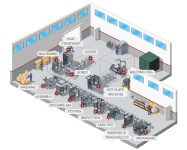What Does a Fully Automated Assembly Line Look Like?
A fully automated assembly line uses advanced machines and robotics to streamline the manufacturing process with minimal human intervention. These lines are designed to boost productivity, reduce human error, and ensure consistent quality in high-volume production environments. In this guide, we’ll explore the components, benefits, and differences between automated and semi-automated assembly systems to help you understand what an optimized modern manufacturing line looks like.
Key Components of an Automated Assembly Line
Modern automated manufacturing lines include specialized equipment that controls part flow, process steps, and quality control. Here are the most common components:
- Industrial Robotics: Handle repetitive tasks such as assembly, welding, painting, and inspection with precision and speed.
- Conveyor Systems: Transfer parts between stations, enabling continuous flow throughout the assembly process.
- Automated Guided Vehicles (AGVs): Transport materials across workstations or departments, improving logistics and reducing manual labor.
- Automated Testing Stations: Perform real-time quality checks to ensure each unit meets required standards.
- Traceability and Marking Equipment: Apply serial numbers, lot codes, or laser marks for compliance and tracking.
- Robotic Packaging Units: Automate end-of-line tasks such as product packaging, palletizing, or tray loading.
- Non-Robot Assembly Stations: Used when robotics are not ideal—flexible solutions for specific tasks or hybrid systems.
Benefits of a Fully Automated Assembly Line
Implementing a fully automated assembly system offers a wide range of measurable benefits:
- Increased Throughput: Continuous operation with minimal downtime improves overall production rates.
- Precision and Consistency: Repeatable actions result in uniform quality and fewer defects.
- Lower Labor Costs: Reduced reliance on manual labor allows better allocation of skilled personnel.
- Improved Workplace Safety: Machines handle hazardous or repetitive tasks, reducing injury risk.
- Built-In Quality Control: Sensors and vision systems detect defects in real-time to minimize scrap.
- Scalability: Easily expand or reconfigure the system to match changing production needs.
- Faster Time to Market: Streamlined workflows allow for quicker response to customer demand.
What Is Semi-Automated Assembly?
A semi-automated assembly line combines human labor with automated machines. These systems are ideal for manufacturers needing greater flexibility, especially in low-volume or high-mix environments. While some stations may be fully automated, others may require manual loading, part alignment, or inspections.
Advantages of Semi-Automation:
- Lower upfront capital investment
- Faster system deployment
- Greater customization and adaptability
- Ideal for prototyping and new product introduction (NPI)
- Human oversight for quality assurance or complex tasks
Automated Assembly Lines: Which Type Is Right for You?
Choosing between a fully automated or semi-automated manufacturing line depends on your product volume, complexity, and business goals. Fully automated systems are perfect for high-output applications with tight tolerances, while semi-automated systems offer more flexibility and lower entry costs.
Partner with AMD for Custom Assembly Line Automation
At Advanced Manufacturing Development (AMD), we specialize in designing and building automated assembly equipment tailored to your exact production requirements. From automated screwdriving and welding cells to robotic handling systems and traceability stations, our engineers will develop a turnkey solution optimized for your workflow.
Our team can visit your facility, assess your processes, and recommend a scalable automation strategy that improves productivity, quality, and ROI.
📩 Contact us or 📄 request a quote today to get started.
Frequently Asked Questions
What is a fully automated assembly line?
A fully automated assembly line is a manufacturing system that uses machines and robotics to handle the complete process from material loading to final packaging, with minimal human involvement.
What are the benefits of automation in an assembly line?
Automation increases productivity, reduces errors, lowers costs, and improves safety and product quality. It also allows for scalable and consistent output.
What is the difference between semi-automated and fully automated systems?
Fully automated systems use machines for all tasks, while semi-automated systems include human intervention for part handling, inspection, or flexible tasks.

